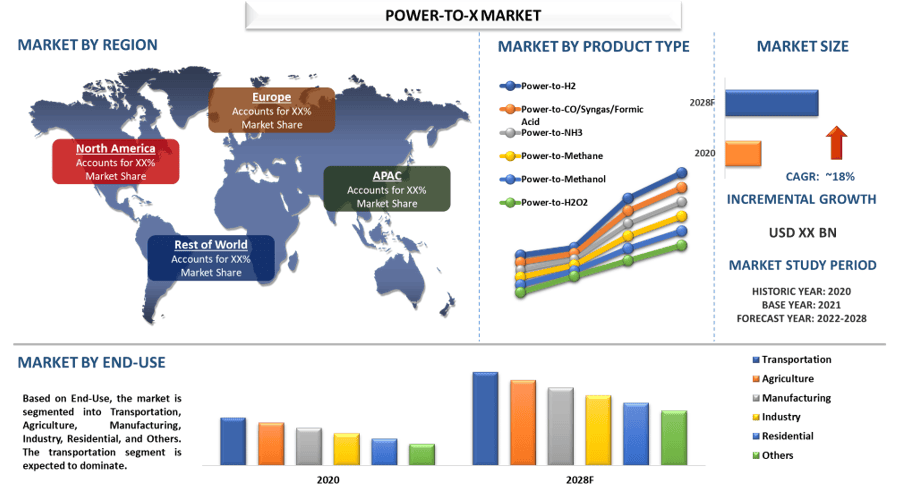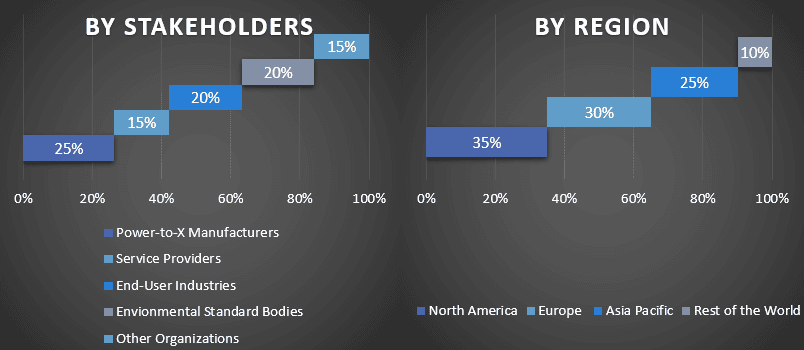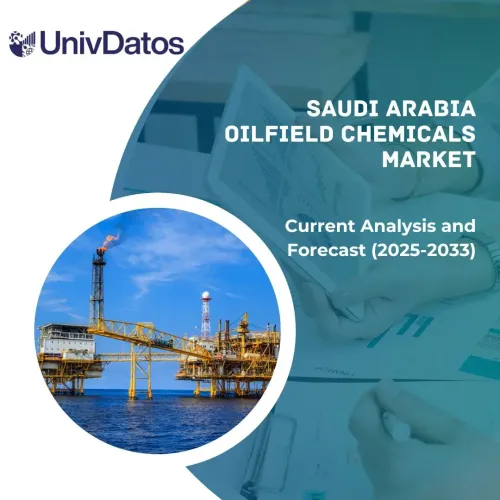- Home
- About Us
- Industry
- Services
- Reading
- Contact Us
Power-to-X Market: Current Analysis and Forecast (2022-2028)
Emphasis on Product Type (Power-to-H2, Power-to-CO/Syngas/Formic Acid, Power-to-NH3, Power-to-Methane, Power-to-Methanol, and Power-to-H2O2); End-Use (Transportation, Agriculture, Manufacturing, Industry, Residential, and Others); Region/Country

The global Power-to-X Market is expected to grow at a significant rate of 18% during the forecast period. Power-to-X technology enables the conversion of electricity into hydrogen, other fuels and even chemicals, which could help solve the dilemma of storing renewable energy. The key technology is electrolysis, where hydrogen is produced from CO2 and water using electricity by splitting water molecules. Using electricity from renewable sources, such as wind or solar energy, the technology can be used to produce hydrogen. Power-to-X makes it possible to completely convert to renewable energy with minimal changes to existing transportation, heating, and industrial infrastructure. And by using industrial CO2 emissions as raw material, power-to-x technologies can help turn the current problem with GHG emissions into a solution.
Moreover, Power-to-X is essential in achieving a carbon neutral society that meets an increasing demand for energy. Also, governments from all over the world have put in place a variety of laws and rules that demand a decrease in carbon emissions from different enterprises. In addition, new technologies are now being deployed at scale across sectors to decarbonise society, limit global warming and combat climate change is creating opportunities for the power-to-X market.
Air Liquide, Copenhagen Infrastructure Partners, MAN Energy Solutions, FH2R, Thyssenkrupp, IRENA, Neles, Underground Sun Conversion, Linde, Mitsubishi Hitachi Power Systems.
Insights Presented in the Report
“Amongst product type, power to hydrogen category to hold substantial share during the forecast period”
Based on the product type, the power-to-X market is segmented into Power-to-H2, Power-to-CO/Syngas/Formic Acid, Power-to-NH3, Power-to-Methane, Power-to-Methanol, and Power-to-H2O2. The power to hydrogen segment caters substantial share of the market. Power can be converted via electrolysis into hydrogen, which can be used directly or in combination with other elements for production of fuels or chemicals. As Hydrogen advantages include eliminating emissions to improve regional air quality while reducing greenhouse gas emissions. Therefore, government across the globe is investing in green hydrogen projects with key players in the market. For instance: In December 2021, NTPC Ltd, India’s integrated energy company has awarded project of ‘Standalone Fuel-Cell based Micro-grid with hydrogen production using electrolyser’ at NTPC Simhadri.
“Amongst end-use, transportation segment to hold a significant share in the market in 2020”
Based on end-use, the power-to-X market is bifurcated into transportation, agriculture, manufacturing, industry, residential, and others. The transportation segment caters considerable share of the market. Increasing demand for eco-friendly vehicle that reduce the carbon footprints is escalating. In addition, green hydrogen can be used as fuel for fuel cells and hydrogen engines, to produce industrial feedstock and to produce sustainable e-fuels for marine, aviation, agriculture, mining and data center power. Therefore, key automobiles market players are making strateges to adopt power-to-X in transporation in the near future. For instance: In 2022, The Rolls-Royce business unit Power Systems and SOWITEC, a specialist in renewable energy projects, have agreed to cooperate with the aim of providing power-to-X projects with a total electrolysis capacity of up to 500 megawatts by 2028.
“Asia Pacific to grow with highest CAGR during the forecasted year”
Asia Pacific is anticipated to grow at a substantial CAGR during the forecast period. This is mainly attributed to the growing industrialization, urbanization and support for renewable energy in the region is anticipated to escalate the market size of power-to-x. In addition, China is dominating the market of green hydrogen and accounts for one-third of the total world production which in turn resulted in accentuate the market size of power-to-x technology.
Reasons to buy this report:
- The study includes market sizing and forecasting analysis validated by authenticated key industry experts.
- The report presents a quick review of overall industry performance at one glance.
- The report covers an in-depth analysis of prominent industry peers with a primary focus on key business financials, product portfolio, expansion strategies, and recent developments.
- Detailed examination of drivers, restraints, key trends, and opportunities prevailing in the industry.
- The study comprehensively covers the market across different segments.
- Deep dive regional level analysis of the industry.
Customization Options:
The global Power-to-X market can further be customized as per the requirement or any other market segment. Besides this, UMI understands that you may have your own business needs, hence feel free to connect with us to get a report that completely suits your requirements.
Table of Content
Research Methodology for the Power-to-X Market Analysis (2022-2028)
Analyzing the historical market, estimating the current market, and forecasting the future market of the global Power-to-X market were the three major steps undertaken to create and analyze the adoption of Power-to-X in major regions globally. Exhaustive secondary research was conducted to collect the historical market numbers and estimate the current market size. Secondly, to validate these insights, numerous findings and assumptions were taken into consideration. Moreover, exhaustive primary interviews were also conducted, with industry experts across the value chain of the global Power-to-X market. Post assumption and validation of market numbers through primary interviews, we employed a top-down/bottom-up approach to forecasting the complete market size. Thereafter, market breakdown and data triangulation methods were adopted to estimate and analyze the market size of segments and sub-segments of the industry pertains to. Detailed methodology is explained below:
Analysis of Historical Market Size
Step 1: In-Depth Study of Secondary Sources:
Detail secondary study was conducted to obtain the historical market size of the Power-to-X market through company internal sources such as annual reports & financial statements, performance presentations, press releases, etc., and external sources including journals, news & articles, government publications, competitor publications, sector reports, third-party database, and other credible publications.
Step 2: Market Segmentation:
After obtaining the historical market size of the Power-to-X market, we conducted a detailed secondary analysis to gather historical market insights and share for different segments & sub-segments for major regions. Major segments are included in the report as product type and end-use. Further country-level analyses were conducted to evaluate the overall adoption of testing models in that region.
Step 3: Factor Analysis:
After acquiring the historical market size of different segments and sub-segments, we conducted a detailed factor analysis to estimate the current market size of the Power-to-X market. Further, we conducted factor analysis using dependent and independent variables such as various product type and end-use. A thorough analysis was conducted for demand and supply-side scenarios considering top partnerships, mergers and acquisitions, business expansion, and product launches in the Power-to-X market sector across the globe.
Current Market Size Estimate & Forecast
Current Market Sizing: Based on actionable insights from the above 3 steps, we arrived at the current market size, key players in the global Power-to-X market, and market shares of the segments. All the required percentage shares split, and market breakdowns were determined using the above-mentioned secondary approach and were verified through primary interviews.
Estimation & Forecasting: For market estimation and forecast, weights were assigned to different factors including drivers & trends, restraints, and opportunities available for the stakeholders. After analyzing these factors, relevant forecasting techniques i.e., the top-down/bottom-up approach were applied to arrive at the market forecast for 2027 for different segments and sub-segments across the major markets globally. The research methodology adopted to estimate the market size encompasses:
- The industry’s market size, in terms of revenue (USD) and the adoption rate of the Power-to-X market across the major markets domestically
- All percentage shares, splits, and breakdowns of market segments and sub-segments
- Key players in the global Power-to-X market in terms of the product offered. Also, the growth strategies adopted by these players to compete in the fast-growing market
Market Size and Share Validation
Primary Research: In-depth interviews were conducted with the Key Opinion Leaders (KOLs) including Top Level Executives (CXO/VPs, Sales Head, Marketing Head, Operational Head, Regional Head, Country Head, etc.) across major regions. Primary research findings were then summarized, and statistical analysis was performed to prove the stated hypothesis. Inputs from primary research were consolidated with secondary findings, hence turning information into actionable insights.
Split of Primary Participants in Different Regions

Market Engineering
The data triangulation technique was employed to complete the overall market estimation and to arrive at precise statistical numbers for each segment and sub-segment of the global Power-to-X market. Data was split into several segments & sub-segments post studying various parameters and trends in the areas of product type and end-use in the global Power-to-X market.
The main objective of the Global Power-to-X Market Study
The current & future market trends of the global Power-to-X market were pinpointed in the study. Investors can gain strategic insights to base their discretion for investments on the qualitative and quantitative analysis performed in the study. Current and future market trends determined the overall attractiveness of the market at a regional level, providing a platform for the industrial participant to exploit the untapped market to benefit from a first-mover advantage. Other quantitative goals of the studies include:
- Analyze the current and forecast market size of the Power-to-X market in terms of value (USD). Also, analyze the current and forecast market size of different segments and sub-segments
- Segments in the study include areas of type of product type and end-use.
- Define and analysis of the regulatory framework for the Power-to-X
- Analyze the value chain involved with the presence of various intermediaries, along with analyzing customer and competitor behaviors of the industry.
- Analyze the current and forecast market size of the Power-to-X market for the major region.
- Major countries of regions studied in the report include Asia Pacific, Europe, North America, and the Rest of the World.
- Company profiles of the Power-to-X market and the growth strategies adopted by the market players to sustain in the fast-growing market
- Deep dive regional level analysis of the industry
Related Reports
Customers who bought this item also bought










